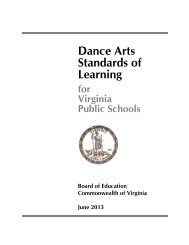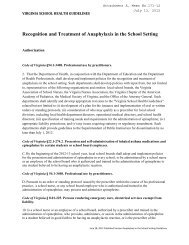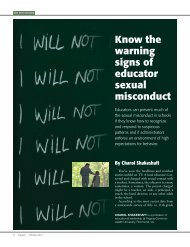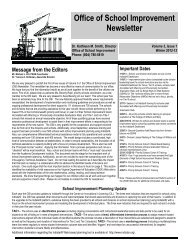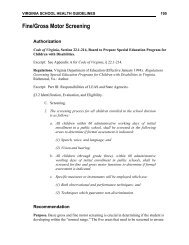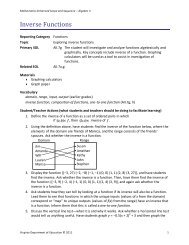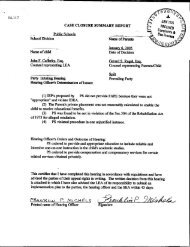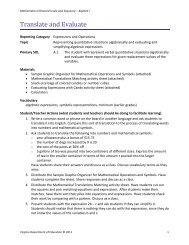What Makes Something Alive - Virginia Department of Education
What Makes Something Alive - Virginia Department of Education
What Makes Something Alive - Virginia Department of Education
You also want an ePaper? Increase the reach of your titles
YUMPU automatically turns print PDFs into web optimized ePapers that Google loves.
Topic 4: Session 4.2 – Butterflies and Moths<br />
Session Supplies:<br />
• Shared statement about animal life cycles written in Topic 4, Session 4.1<br />
• Butterfly and Moth sheets (pg. 117-131)<br />
• Pattern blocks or small 1 x 1 centimeter squares <strong>of</strong> colored paper<br />
• Butterfly Wing Template sheet (pg. 132)<br />
Session <strong>Virginia</strong> SOL<br />
Science English Mathematics History & Social Science<br />
2.15<br />
2.1 a, b, c, d, i, j, k<br />
2.4 a<br />
2.7 a<br />
Session 4.2 – Butterflies and Moths<br />
Teacher Questions & Notes<br />
-Do you think all butterflies have the<br />
same life cycle?<br />
-<strong>What</strong> are the stages <strong>of</strong> a moth‟s life<br />
cycle? (egg, larva-caterpillar, pupacocoon,<br />
moth)<br />
-How are the stages <strong>of</strong> the butterfly‟s<br />
life cycle and the stages <strong>of</strong> the moth‟s<br />
life cycle alike? Different? (pupa for a<br />
butterfly is a chrysalis, pupa for a<br />
moth is a cocoon)<br />
Procedures<br />
1. Begin the lesson by reviewing the shared statement and stages in<br />
a butterfly life cycle discussed in Topic 4, Session 4.1.<br />
2. Discuss the life cycle <strong>of</strong> a moth.<br />
3. Compare how the life cycle <strong>of</strong> a butterfly and a moth are the same<br />
and how they are different.<br />
4. Show the pictures <strong>of</strong> a variety <strong>of</strong> different butterflies and moths<br />
found on the Butterfly and Moth sheets.<br />
For other pictures, you can use the computer to project<br />
photographs up on the screen. “Google Images” is a great<br />
resource. If technology is not readily accessible, you can also<br />
use photographs from nonfiction books.<br />
5. Guide students to understand that different species <strong>of</strong> butterflies<br />
go through the same life-cycle stages and the different species <strong>of</strong><br />
moths go through the same life-cycle stages.<br />
6. As a class, review the photographs. Discuss similarities and<br />
differences between the different butterflies and moths. (Refer to<br />
the “Teacher Background Knowledge” section <strong>of</strong> the “Topic 4<br />
Overview” (pg. 111-112))<br />
7. Compare the differences between butterflies and moths.<br />
-<strong>What</strong> is symmetry?<br />
-Why do you think we see symmetry<br />
in nature?<br />
8. Allow students to brainstorm ideas, but guide them toward the<br />
symmetrical characteristics <strong>of</strong> the butterfly and moth wings.<br />
115<br />
<strong>Virginia</strong> Animals and their Habitats<br />
Topic 4





